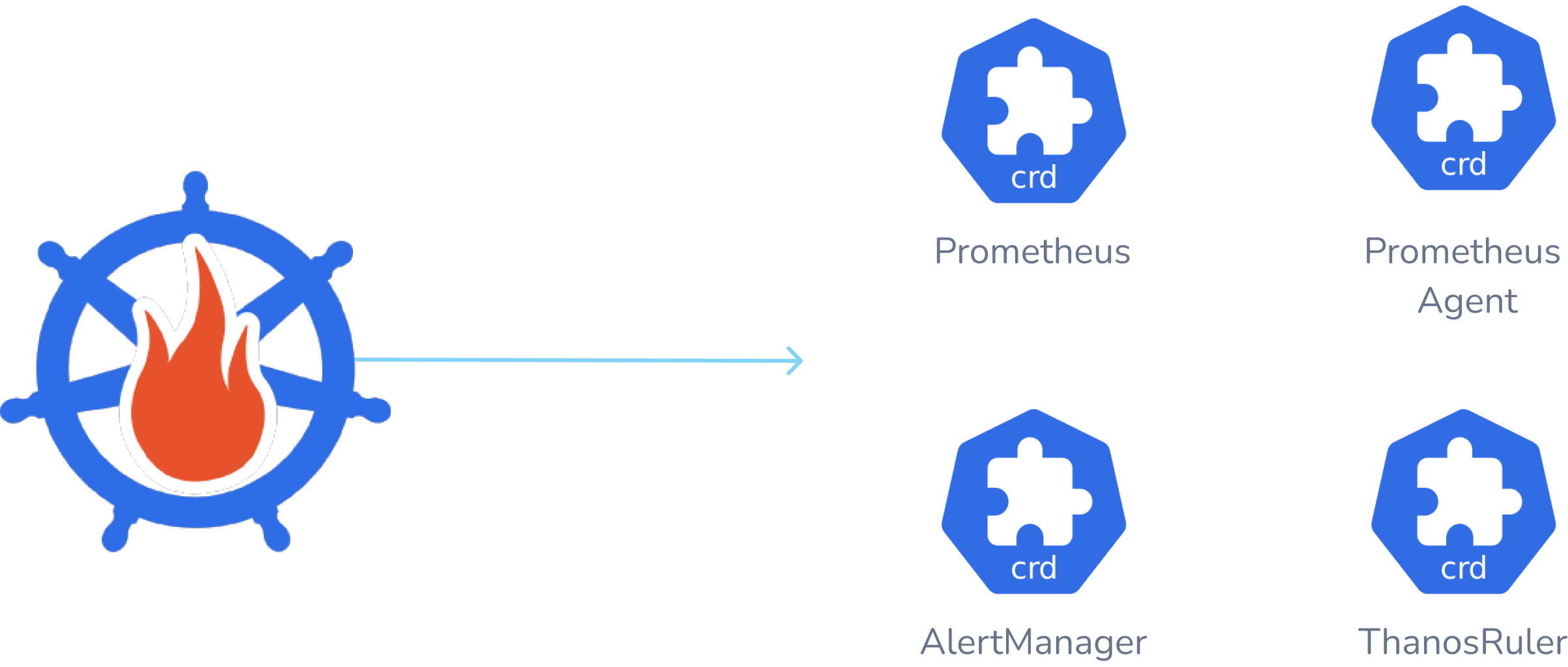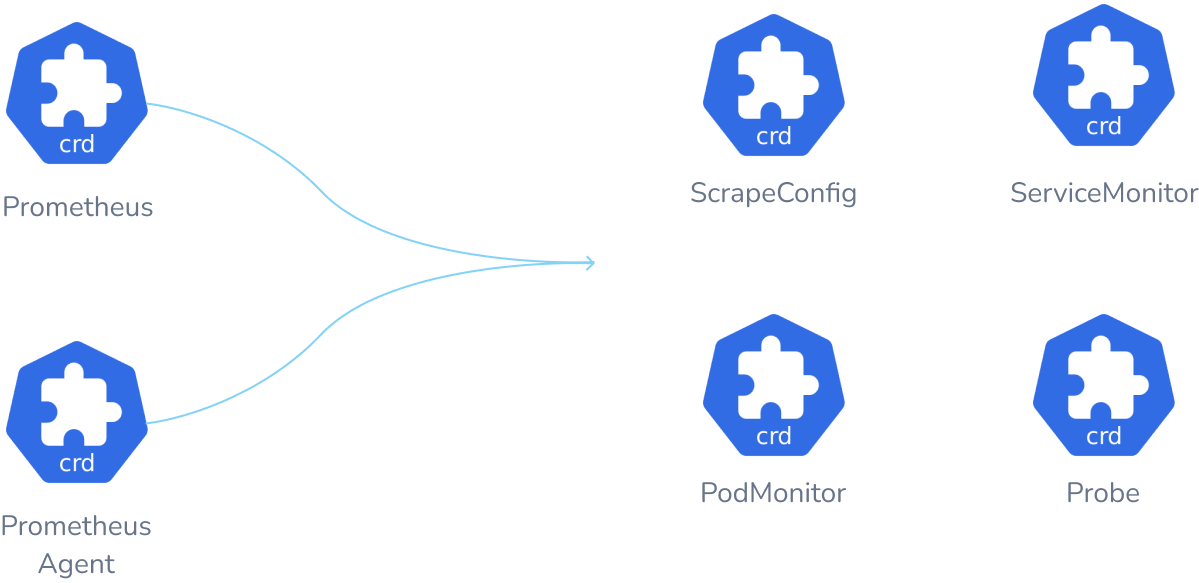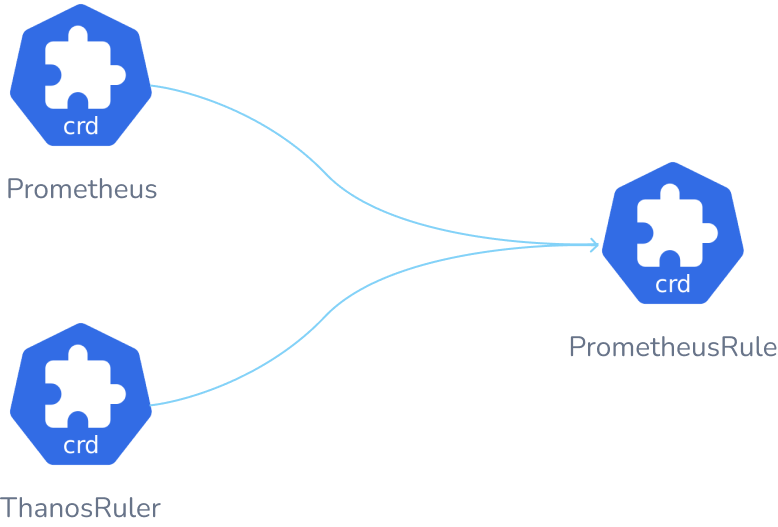Design
This document describes the design and interaction between the custom resource definitions that the Prometheus Operator manages.
The custom resources managed by the Prometheus Operator are:
- Prometheus
- Alertmanager
- ThanosRuler
- PrometheusAgent
- ServiceMonitor
- PodMonitor
- Probe
- ScrapeConfig
- AlertmanagerConfig
- PrometheusRule
For a better understanding of all these custom resources, let us classify them into two major groups:
Instance-Based Resources

Instance-based resources are used to manage the deployment and lifecycle of different components in the Prometheus ecosystem, as shown in the above figure. Let us look into the features of each of these custom resources:
Prometheus
The Prometheus CRD sets up a Prometheus instance in a Kubernetes cluster. It allows configuration of replicas, persistent storage, and Alertmanagers for sending alerts. For each Prometheus resource, the Operator deploys StatefulSet objects (one per shard, default is 1) in the same namespace.
Alertmanager
The Alertmanager CRD sets up a Alertmanager instance in a Kubernetes cluster. It provides options to configure the number of replicas and persistent storage. For each Alertmanager resource, the Operator deploys a StatefulSet in the same namespace. For multiple replicas, the operator runs the Alertmanager instances in high availability mode.
ThanosRuler
The ThanosRuler CRD sets up a Thanos Ruler instance in a Kubernetes cluster. It enables the processing of recording and alerting rules across multiple Prometheus instances. A ThanosRuler instance needs at least one query endpoint that connects to Thanos Queriers or Prometheus instances. More details can be found in the Thanos section.
Prometheus Agent
The Prometheus Agent CRD sets up a Prometheus Agent instance in a Kubernetes cluster. While similar to the Prometheus CR, the Prometheus Agent has several configuration options redacted, including alerting, PrometheusRules selectors, remote-read, storage, and Thanos sidecars. To understand why Agent support was introduced, read the proposal here.
Config-Based Resources
Config-based resources focus on managing the monitoring of resources and scraping metrics within a Kubernetes cluster. They define how metrics are collected, processed, and managed, rather than managing the deployment of the monitoring components themselves. For a clear picture, let us look at the relation of config-based resources with instance based resources.

The Prometheus and PrometheusAgent CRDs use the podMonitorSelector, serviceMonitorSelector, probeSelector, and scrapeConfigSelector fields to determine which ServiceMonitor, PodMonitor, Probe, and ScrapeConfig configurations should be included in the Prometheus and PrometheusAgent instances for scraping.
ServiceMonitor
The ServiceMonitor CRD defines how a dynamic set of services should be monitored. A Service object discovers pods by a label selector and adds those to the EndpointSlice or Endpoints object. The ServiceMonitor object discovers those EndpointSlice or Endpoints objects and configures Prometheus to monitor those pods. The services selected to be monitored with the desired configuration are defined using label selections.
PodMonitor
The PodMonitor CRD defines how a dynamic set of pods should be monitored. The PodMonitor object discovers these pods and generates the relevant configuration for the Prometheus server to monitor them. The pods selected to be monitored with the desired configuration is defined using label selections.
Probe
The Probe CRD defines how groups of ingresses and static targets should be monitored. Besides the target, the Probe object requires a prober which is the service that monitors the target and provides metrics for Prometheus to scrape. Typically, this is achieved using the blackbox exporter.
ScrapeConfig
The ScrapeConfig CRD allows you to define how Prometheus should discover and scrape metrics from target services. You can use the ScrapeConfig CRD to scrape targets external to the Kubernetes cluster or to create scrape configurations that are not possible with the higher-level ServiceMonitor, Probe, or PodMonitor resources. Both the Prometheus and PrometheusAgent CRDs have a scrapeConfigSelector field, which needs to be set to a list of labels to match ScrapeConfigs.
AlertmanagerConfig

The AlertmanagerConfig CRD allows us to configure Alertmanager instances in a Kubernetes cluster. It specifies subsections of the Alertmanager configuration, enabling the routing of alerts to custom receivers and the setting of inhibition rules.
PrometheusRule

The PrometheusRule CRD allows the definition of alerting and recording rules to be consumed by Prometheus or Thanos Ruler instances. Alerts and recording rules are reconciled by the Operator and dynamically loaded without requiring a restart of Prometheus or Thanos Ruler.